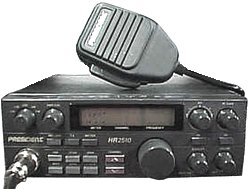Uniden President HR2510
The President HR2510 is an all mode 10 meter radio. It has AM, FM, LSB, USB and CW modes. 6 digit frequency display and built in SWR meter. An unlocked HR-2510 can have coverage from 24.800 - 29.999 MHz. It can transmit up to 30 watts and are tunable up to 40 watts.
Radio Shack produce a model called the HTX100 branded under Realistic trademark or the name Radio Shack. The HTX100 was a crippled version of the President HR2510. The Emperor TS-5010 is also comparable, and has the same output finals. The HR2510 and TS5010 transmit up to about 30 watts.
With a General Class HAM radio license, using the HR2510 is both legal and productive for making long distance contacts on 10-meter with excellent signal reports.
Due to the abuse of this radio, as in the illegal modifications allowing unlicensed individuals to operate on CB band, the FCC has deemed the President HR250 as "blacklisted." This may be referred to as having an unlocked clarifier. The FCC Market Blacklist due to CB Related Abuse does not make it illegal to own or buy this radio. It is illegal to market and advertise the product, so manufacture, import, and commercial sale of the President HR2510 was banned by the FCC. It is unfortunate as this truly is a 5-star 10-meter rig when used legally.
The President HR2510 was relatively inexpensive and could allow an entry level Tech class licensed HAM to make distant contacts on the HR band. In fact, a tech class is allowed CW, Data, and RTTY from 28.0 to 28.3Mhz. A Tech can also use SSB/CW from 28.3 to 28.5Mhz. This opens up an area of HF for the teach class for under $200.
LEGAL USE OF MODIFIED RADIO: It is true that in the event of a life threatening emergency, where all other forms of communication have been exhausted, you may operate out-of-band to find help. The FCC will forgive this out-of-band use in a life threatening emergency. Also, the disaster preparation community prefers to have these radios "unlocked" so the option is available in an emergency. An unlocked Uniden President HR2510 may still be legally operated within the correct band for a licensed operator, reserving the use of out-of-band frequencies for an extreme emergency situation. That's why it is nice to have it unlocked, even though it should not be used out-of-band.
Controls
- Mode Selector - Selects CW, AM, FM, USB, or LSB.
- SWR CAL - Adjust the calibration of the SWR meter wile in the SWR CAL mode.
- RIT Control - The Receiver Incremental Tuning control match your xmit freq with rec freq. Very sensitive.
- RF Gain Control. - Varies the RF input to the receiver and helps eliminate strong, adjacent signals.
- Mic Gain. - Selects a lower Mic gain level. More gain is preferable unless distortion occurs.
- TX Switch - Locks the transmitter in the on position. This should be glued so it cannot be pressed.
- Meter Switch - Selects either RF/S, MOD, SWR CAL, or SWR.
- PA Switch - Selects the PA Mode if an external PA speaker is connected. Useless.
- NB Switch - Helps eliminate interference generated by vehicle ignition systems.
- Dim Switch - Selects the level of the backlight of the display.
- Scan Control - Used to scan up to 50 channels in each band segment.
- Span Control - Select 10 KHz, 1 KHz, or 100 Hz steps for the VFO.
- Channel UP/DOWN- Step up or down to the next 10 KHz channel in the currently selected band segment.
- Roger Beep- beep tone when you release the PTT switch. Should never be used, HAM ops dislike.
- Band Control - Selects one of four bands.
- F. Lock - Disables all frequency controls [except RIT] to prevent accidental changes of frequency.
- VFO Control - Digital Variable Frequency Oscillator control used to select the desired frequency.
- Squelch - Squelch weak and unwanted signal noise.
- Volume Control - Turns the unit on or off and adjusts the volume.
